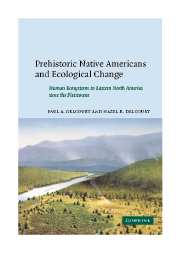 Prehistoric Native Americans and Ecological Change
Prehistoric Native Americans and Ecological Change 9 - The ecological legacy of prehistoric Native Americans
Published online by Cambridge University Press: 30 October 2009
Summary
THE MYTH OF THE PRISTINE FOREST
The explicitly stated choice of targets for ecological land management efforts in the United States mandates a “return to the presettlement equilibrium,” defined as a preColumbian baseline (Peacock, 1998; Kimmerer, 2000; Kloor, 2000). Since the inception of academic ecology in the United States at the turn of the twentieth century, scientific investigations have been predicated on the assumption that the North American continent has been relatively undisturbed by human activities, giving investigators a series of “natural experiments” from which fundamental relationships of plants and animals to their environment can be ascertained (Wright, 1977; McIntosh, 1985; Risser et al., 1984). During much of the twentieth century, ecologists also viewed the original vegetation and fauna of North America as being in a steady state, in equilibrium with climate and other environmental factors (McIntosh, 1985; Golley, 1984).
Both the assumption that ecosystems existing prior to the time of European American settlement were untouched by Native American activities and that they were in a state of equilibrium have been questioned, based upon a number of lines of reasoning, as well as historical and prehistoric information (Denevan, 1992; Kay, 1995; Hamel and Buckner, 1998; Peacock, 1998; Krech, 1999; Redman, 1999; Kimmerer, 2000; Minnis and Elisens, 2000).
“The forests the settlers saw”
Ecological methods have been developed to assess the distribution and composition of vegetation existing at the time of the westward expansion of European American settlement, using records from the General Land Office Surveys, under the assumption that “the forests the settlers saw” were representative of pristine “presettlement” wilderness (Bourdo, 1956, 1983; Marschner, 1959, 1974; Williams, 1989).
- Type
- Chapter
- Information
- Prehistoric Native Americans and Ecological ChangeHuman Ecosystems in Eastern North America since the Pleistocene, pp. 162 - 169Publisher: Cambridge University PressPrint publication year: 2004


